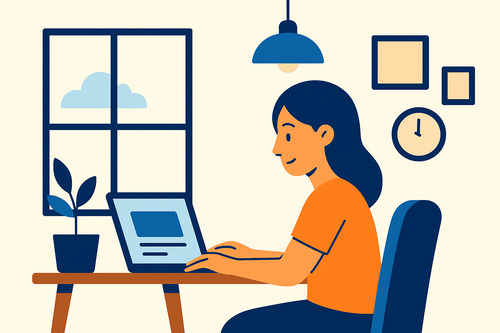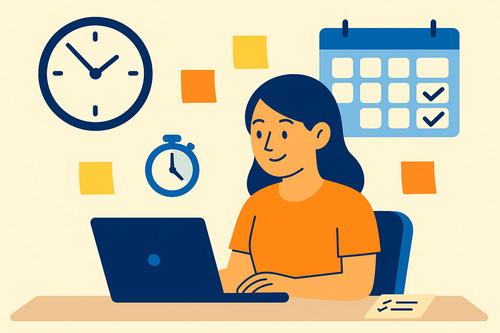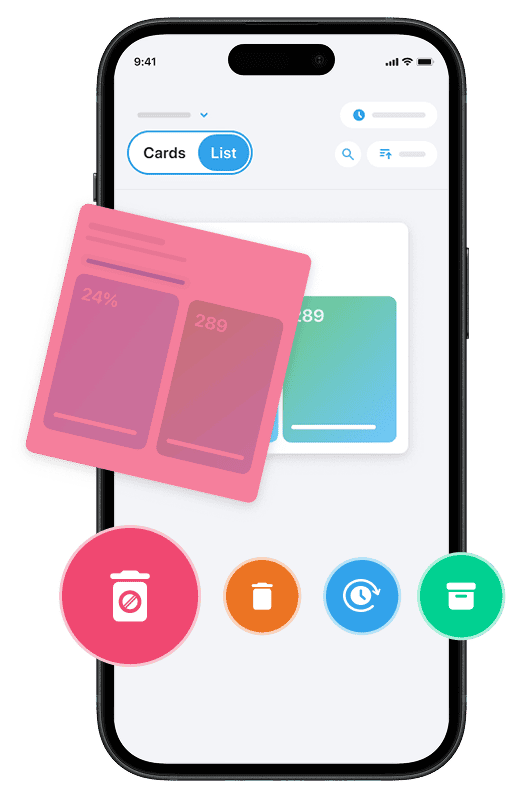In today’s digital age, remote workers and professionals encounter unique challenges in maintaining healthy digital habits that enhance both productivity and well-being. With the growing reliance on technology, screens, and online platforms during the workday, it’s important to develop a balanced approach to managing digital time and screen use.
Cultivating good digital habits not only helps you effectively manage time online, but it also supports healthier mental and physical health, reduces digital fatigue, and encourages positive social interactions.
By adopting healthier digital practices, such as setting boundaries around screen time and engaging with technology mindfully, you can improve your digital well-being and create a more sustainable, healthier digital work lifestyle.
One great way to build better Healthy Digital Habits as a remote worker is by using our Cleanfox platform. It lets you clean all your spam and unwanted emails with just one click.
Setting Boundaries and Managing Time
Establishing a Dedicated Workspace
Creating a dedicated workspace at home is fundamental to cultivating healthier digital habits and maintaining focus during your remote work hours. This space should be quiet, organized, and free of household distractions, allowing you to mentally shift into work mode.
Whether it’s a spare room, a corner of your dining area, or a customized nook, ensure your workstation has access to natural light and privacy for calls and meetings. An organized desk with proper screen arrangement supports your digital wellbeing by reducing clutter and minimizing passive screen time distractions. By clearly separating work from relaxation areas, you help build a healthier balance between your professional activities and family life, which is critical for mental health and overall productivity.

Scheduling and Time Management Techniques
Managing your time effectively is important in preventing excessive screen time and digital fatigue. Utilize scheduling techniques such as time blocking or the Pomodoro method to allocate focused intervals for work, breaks, and physical activity. This structured approach helps you avoid the pitfalls of endless scrolling on social media or passive screen use during work hours.
Incorporating reminders to step away from devices enhances both your physical health and mental wellbeing. It also supports healthier digital habits by encouraging you to be intentional about how you spend your online time and to prioritize offline activities, fostering a better balance in the digital age.

Using Technology to Your Advantage
Leverage technology tools, such as digital wellbeing apps and calendar alerts, to build good digital habits and monitor your screen time. Features that limit notifications or block distracting websites can help reduce compulsive social media video scrolling and other unproductive online behaviors. Employing cloud-based collaboration platforms and integrated communication tools not only streamlines your workflow but also encourages efficient online experiences.
Adopting these tools enables you to reinforce boundaries, increase productivity, and promote healthier digital habits, ultimately supporting your mental and physical health while working remotely.
Ensuring Cybersecurity and Data Protection
Say goodbye to spam, clutter, and chaos.
Our smart email cleaner filters out junk, organizes your inbox, and helps you focus on what really matters.
✅ Block spam automatically
✅ Organize emails by priority
✅ Keep your inbox clean
✅ Clean old emails you don’t read
📱 Available on the App Store and Google Play.
Securing Home Networks and Devices
Protecting your home network and devices is a fundamental step in maintaining safe online experiences while working remotely. Ensure your Wi-Fi network is secured with a strong, unique password and WPA3 encryption, if available. Avoid using public Wi-Fi for work-related activities, or utilize a trusted VPN service to encrypt your internet traffic and shield sensitive data.
Devices such as laptops, smartphones, and tablets should have updated antivirus and internet security software installed. Separating work devices from personal ones can further reduce risks by limiting exposure to threats that commonly affect consumer devices and apps.
Additionally, physically covering webcams when not in use adds an extra layer of privacy protection against unauthorized access.
Regular Updates and Maintenance
Consistently updating your operating system, applications, and security tools is vital to closing vulnerabilities that cybercriminals may exploit. Set updates to install automatically or regularly check for patches, especially for any remote-work-related software. This includes browsers, communication platforms, and VPN clients.
Ignoring updates increases the risks of malware infections and unauthorized data access. Maintaining these digital habits helps safeguard your work environment and preserves the integrity of your digital wellbeing and online safety.
Safe Communication Practices
Practicing safe communication is key to protecting sensitive information while collaborating online. Use encrypted messaging and video conferencing platforms approved by your organization to ensure data is transmitted securely. Be vigilant against phishing attempts, avoiding clicking on suspicious links or downloading attachments from unknown sources.
Employ multi-factor authentication (MFA) whenever possible to add an extra layer of verification before gaining access to your work accounts. These secure habits not only protect your professional data but also contribute to building a culture of digital citizenship and safer online experiences for you and your team.
Maintaining Mental and Physical Health
Regular Breaks and Physical Activity
Integrating regular breaks into your workday is essential for sustaining physical health while working remotely. Sitting for prolonged periods can lead to musculoskeletal pain, poor posture, and fatigue.
To counteract this, experts recommend short movement breaks every 30 to 45 minutes. Simple activities like stretching your back, neck, and shoulders or walking around your space can rejuvenate your body and mind. Incorporating more sustained physical activity, such as moderate-intensity exercise totaling at least 150 minutes per week, supports muscular endurance, flexibility, and overall well-being. These habits help you maintain healthy technology habits by reducing the physical risks associated with excessive screen time and sedentary behaviors.
Balancing Screen Time
Balancing the amount of time you spend in front of screens is important for protecting your eyes and mental health. Prolonged exposure to blue light from digital devices can disrupt sleep patterns and cause eye strain. Implementing strategies like the 20-20-20 rule—looking away every 20 minutes at something 20 feet away for 20 seconds—can alleviate eye fatigue.
Additionally, consciously reducing passive screen time, such as mindless scrolling on social media video feeds, allows your brain to rest and prevents digital burnout. To learn more about how to protect your focus and avoid exhaustion in a tech-driven work environment, read our guide on how to prevent digital burnout and stay focused at work.
Setting boundaries for when and how you engage with digital devices throughout the day fosters healthier digital habits and encourages a better balance between work and offline activities.
Mindfulness and Stress Management
Remote work can blur the lines between professional and personal life, increasing stress and impacting mental wellbeing. Practicing mindfulness techniques such as meditation, deep breathing exercises, or digital detox periods can mitigate these effects. Purposeful breaks from screens not only improve mental clarity but also enhance digital wellbeing by reducing cognitive overload.
Prioritizing mental health through these practices supports healthier digital habits and empowers you to engage more intentionally online. Moreover, adopting stress management strategies helps you maintain resilience and cultivate a positive mindset, making your remote work experience more sustainable and fulfilling.
Conclusion
To truly thrive as a remote worker or professional, it’s important to adopt healthy digital habits. Start by setting clear boundaries—create a dedicated workspace and manage your time with intention. Additionally, prioritize cybersecurity by securing your devices and practicing safe communication methods.
Equally important is maintaining your mental and physical health. Incorporate regular breaks, balanced screen time, and mindfulness activities into your routine. By embracing these habits, you’ll not only boost your productivity but also safeguard your overall wellbeing in this digital era. Take proactive steps today to cultivate a healthier digital lifestyle that supports both your career and personal life.
FAQ
How can remote workers maintain a healthy work-life balance while working digitally?
Remote workers can maintain a healthy work-life balance by setting and adhering to regular work schedules, establishing clear boundaries between work and personal spaces, reducing distractions, and taking regular breaks. Support from colleagues and leaders plays a key role in enhancing this balance. Additionally, prioritizing communication and separating work areas from rest spaces are important strategies for long-term success.
What strategies help reduce digital fatigue and prevent burnout in remote professionals?
To reduce digital fatigue and prevent burnout, remote professionals can adopt smart scheduling with buffer breaks, set clear work-life boundaries, and take regular screen breaks using techniques like the Pomodoro Technique. Incorporating digital detox periods, creating ergonomic workspaces, using diverse communication modes, promoting physical movement, and fostering open social connections are all effective ways to support mental health and well-being.
How can remote workers build and sustain effective communication habits with their teams?
Remote workers can build and sustain effective communication habits by setting clear expectations, using appropriate tools, and scheduling consistent meetings, such as weekly one-on-ones. Encouraging open dialogue, offering feedback opportunities, clearly defining responsibilities, and engaging in team-building activities can help reduce isolation and ensure alignment and engagement despite physical distance.
What are some recommended practices for optimizing a home workspace for better productivity and health?
To optimize your home workspace, focus on decluttering and using efficient storage solutions like floating shelves and under-desk cabinets. Ensure good lighting through layered sources to reduce glare and eye strain.
Invest in ergonomic seating and a tailored desk setup that suits your needs. Personalizing your workspace and maintaining clear boundaries between work and home life can significantly boost productivity and health. Additionally, varying your posture, incorporating footrests, and taking regular breaks will help prevent discomfort and improve your overall workflow.
This was our article on Healthy Digital Habits for Remote Workers and Professionals. If you’d like to explore more related topics, visit our blog.



